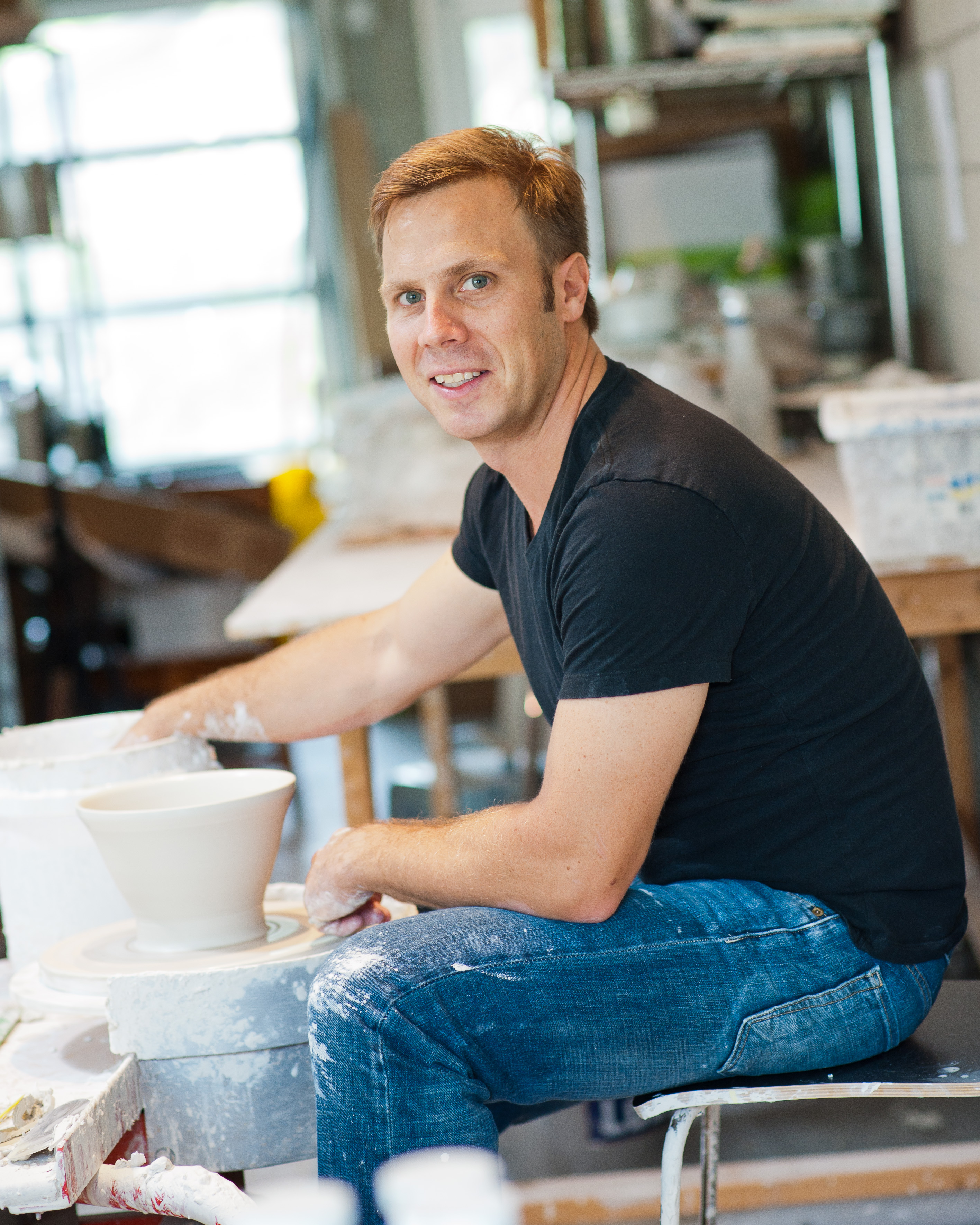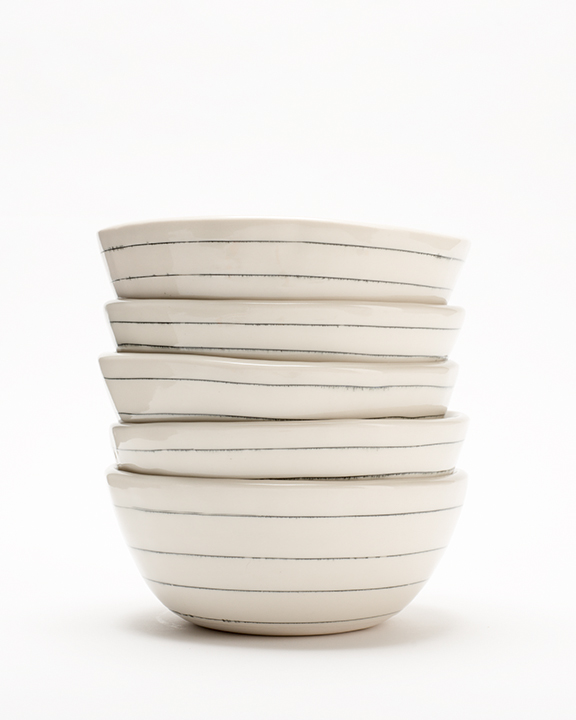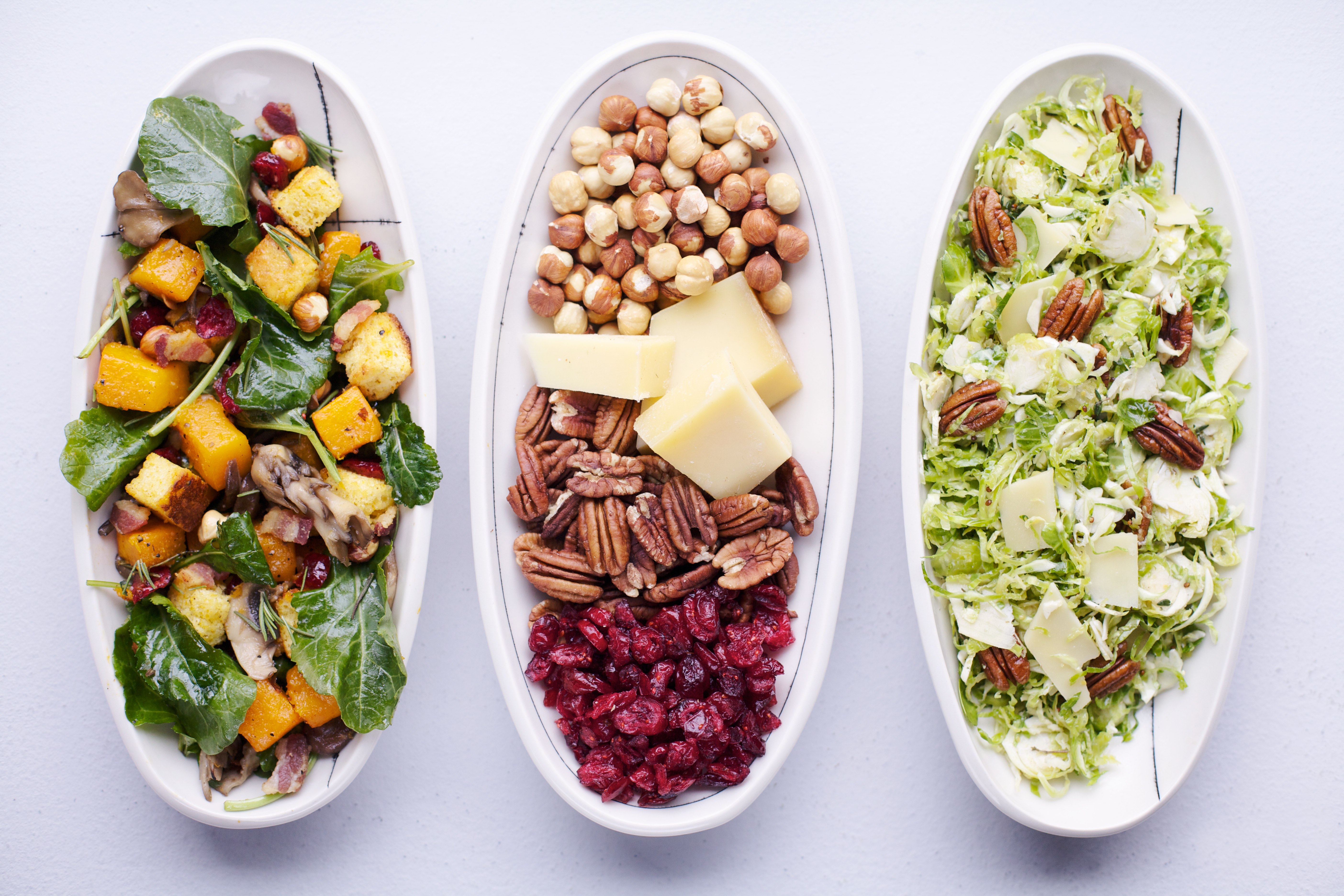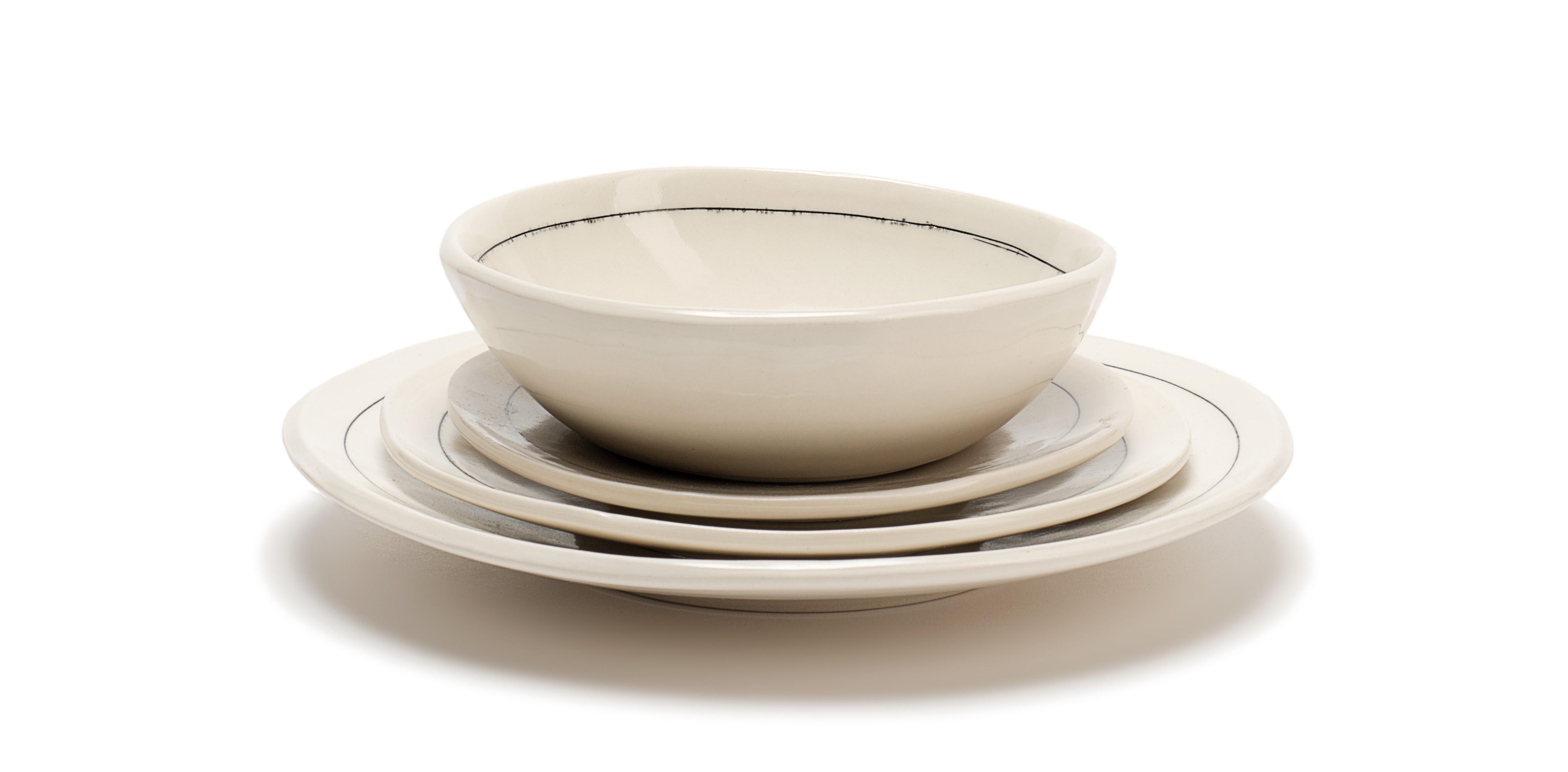Keith Kreeger is a designer artist and maker whose work graces the tables of some of the countries best restaurants. You can find more of his work here.
Tell us a little about where you grew up?
I grew up just outside of New York City in Westchester County. Most of my family is still in New York and I go back for work often. Even though I’m living in Texas, New York is still a big part of my life.
How did you first get interested in pottery?
I took my first class when I was in high school but it was at Skidmore College when I really became serious about working with clay. I took a class during a summer session after my sophomore year, which was a big switch from the previous summer when I had interned on Capitol Hill. About 1 week into that first clay session I was working in the studio 10 hours a day and couldn’t wait to get back in there. About halfway through that session I met Toshiko Takaezu who came to Skidmore every summer to make some work. Next thing I knew I was pulling an all-nighter with Toshiko, her apprentice and a couple of other students as Toshiko made a 6 foot tall thrown form. That level of effort and concentration was amazing to me. I spent the rest of my time in college figuring out how to spend the most amount of time in the studio.

What is the most satisfying/challenging aspect of your work?
Working in the studio is obviously a process driven endeavor. Because of that it’s incredibly rewarding to see the work flow from start to finish on a daily basis. There aren’t too many jobs that allow a person to see the results of their effort every day. It’s very similar to cooking in that sense. In the studio there are steps to follow and you’re constantly reacting to the materials at each stage of the process. Each moment in each round of work becomes information and part of a library of ideas to pull from for future work. I absolutely love revisiting an idea or form with skills and techniques that have evolved through the years.
As for challenges, working in the studio is physical work and certain tasks can be arduous and some are even tedious…but each of those steps is necessary to get the quality of finished work that I’m after. I often joke that as soon as we solve a problem in the studio within a process we’ll add another step or complication. I think the biggest issue in the studio right now is editing down the collections…finding the pieces that work best and the designs that succeed as part of a larger conversation. We are constantly tweaking ideas and trying new things.
In 2009 you moved your studio from Cape Cod Massachusetts to Austin, Texas. What prompted the move and how has the relocation influenced your work?
I loved living on the Cape and I built my first studio there long before I was ready to take on that endeavor. That turned out to be a good thing because I learned a lot about the process and a lot about myself that way. The Cape was so busy for the 4 months a year but in those long winters I often found myself in the studio at odd hours trying as many different things as possible. In 2009 my wife and I decided to move because we were ready for a city again. It turned out to be a good time to move and it definitely brought new inspiration to my work. I have been greatly inspired by the creative community in Austin. It’s a vibrant city that pulls its energy from so many sources…artists, tech companies, musicians, start-ups and the food community are all intertwined and are helping the city grow. I like to say that even my friends with boring jobs are doing interesting things. Without rambling further…I think my work has become cleaner and more contemporary since moving to Austin.

Your work is the canvas for some of the country’s top chefs. Can you tell us a little about the collaboration process when working with chefs?
It’s very exciting to be working with chefs and I love seeing how each of their ideas show up on my work. I’ve always loved working with other creative groups and this collaboration just makes so much sense since so much of my work is made to serve food. The use of handmade wares in restaurants is obviously a trend at this point. What I find most important is that we communicate and educate each other so we keep the quality as high as possible. Just because something is handmade doesn’t give it an inherent good that warrants use. If you look around the tabletop world you even have commercial dinnerware manufacturers coming out with “craft” collections. I’m very deliberate with each piece that leaves my studio and am always thinking of how my work will be used. It’s incredibly humbling for me to know that on a given night around the country that so many people are using my work.
My process of working with chefs has a few options. One version is simply a chef choosing our standard collections for their spaces. Another way to work together is to come up with custom wares for the space. It could be as simple as a variation of one of my collections, which is what we’re doing for Tim Maslow at Ribelle. I just finished working on a series of carafes for another client’s water service. We’re definitely not a fabricating studio, but I’ve been lucky to have gotten calls from chefs who have an idea and give me the creative freedom to run with their ideas. Basically, I can make an entire line of tableware for a space or my work can be used to highlight a part of the service or decor within the greater setting of the restaurant.
As Paul Qui gets ready to open his tasting room I’ve been working on an exclusive line for him. The components are very geometric and modular for kitchen to work with. Paul recently texted me a photo of an egg with a cracked shell asking if we could make it out of porcelain. That’s not something I normally would have tried but we made some porcelain eggs and I think it’s going to be a pretty special part of the experience in the tasting room.

We really enjoyed following your recent trip to Japan on Instagram. Was it your first time there? Can you share what surprised/delighted you, culinarily and or related to Japanese ceramics?
My wife and I were lucky enough to travel to Japan last fall for my brother-in-law’s wedding. The wedding was beautiful, in a Shinto shrine in Tokyo. The history of ceramics in Japan is amazing and I would love to go back for a more pottery-focused trip. We traveled through Tokyo and Kyoto but didn’t make it to any of the outlying pottery villages. We had some amazing meals and since my sister-in-law is from Tokyo we had a great guide for information. The best piece of advice from her was that instead of looking for a restaurant, decide on the type of food you want and go to the neighborhood that specializes in that. Under the train tracks in a smoke filled alley in Ginza we had incredible Yakitori. We had some great meals as part of the wedding group. My wife was a little worried about food so ramen became our safe meal and was our go to food throughout the trip. We also had one splurge meal on our last night in Japan at Ryugin. It was an amazing experience from start to finish. And, as a pottery nerd I was blown away by the level of ceramics used in the restaurant. There was an abalone served with an abalone broth. That broth came in a little cup from a kiln in Shigaraki. I’m sure that the cup was worth at least $1500. The object and its importance to the experience was incredibly inspiring to see.
By far our favorite experience was also the “worst” food of the entire trip. We were in Kyoto and wanted the most un-touristy experience we could have. We kept peeking in restaurants looking for a lack of foreigners and we finally found one. We sat at the counter surrounded by 70 year old Japanese men and ordered the set menu. The 80 year old woman who owned the restaurant tried to communicate to us to make sure that’s what we wanted. It was a meal full of awkward smiles and lots of pointing to explain what everything was. The food was so purely old school Japanese, full of textures and flavors that our western palates couldn’t really handle. But, by the end of the evening one man had finally asked laughingly why we were eating there. Another diner was pouring us shochu from the bottle he brought with him. My wife had about 12 plates of unfinished food in front of her since they wouldn’t clear a dish until all of the food was gone. We took pictures with the owner, her son who helped in the kitchen and her daughter who was serving. They walked us out and we all smiled and laughed and waved. We were going to circle back to get a picture of the restaurant but they were still outside laughing and waving when we were halfway down the block. It was the exact experience we were looking for…welcomed into another culture through food and hospitality.

What are your go to restaurant recommendations in Austin?
The restaurant scene in Austin has just blown up since 2009 and there are so many fantastic choices now. Start any evening with a cocktail at either Whisler’s or Weather Up.
Obviously, I’m going to suggest Qui so you can eat off my so many of my plates. Enjoy the ride that Paul and his crew take you on. One of my favorite restaurants in town is Justine’s Brasserie. It’s like walking into another world and I love what Chef Casey Wilcox is cooking. The pork chop is incredible and the potato gratin is insanely delicious. Make sure you order from his daily menu where he gets super creative and pulls from an array of influences that all work within the brasserie setting. It’s also a great late night choice as the kitchen serves until 1am. I never thought that I’d move to Austin find my favorite sushi restaurant but get to Uchi and enjoy as much as the menu as you can. You’re going to have to get tacos while you’re here and I love the Veracruz All Natural trailer…go for the migas breakfast tacos. Ramen Tatsu-Ya is a must as well. The tonkotsu broth is amazing and the marinated soft-boiled egg is as perfect as it gets.
In Boston get to Ribelle and check out what Tim Maslow is cooking…easily one of the best meals I have had all year. Also, Coppa is fantastic and the lobster rolls at Neptune Oyster are the absolute best I’ve ever had. In NYC I love Sushi Zen for straight up old school sushi. I have had a couple of really great meals at Toro recently. I want Pearl and Ash to open in Austin…great food at a great price and a wine list that satisfies everybody. I’m dreaming of their octopus dish right now. Twice a year I bring a new collection to the market at the Javits. As soon as I finish packing up the show I head directly to Esca for oysters, crudo and one of the daily pastas…it’s a great way to finish the trip…I’m a big fan of rituals.

